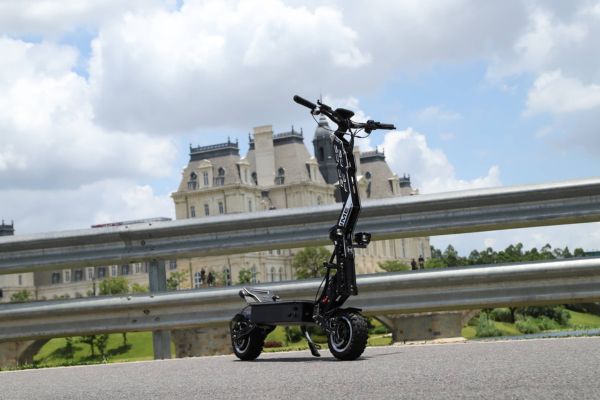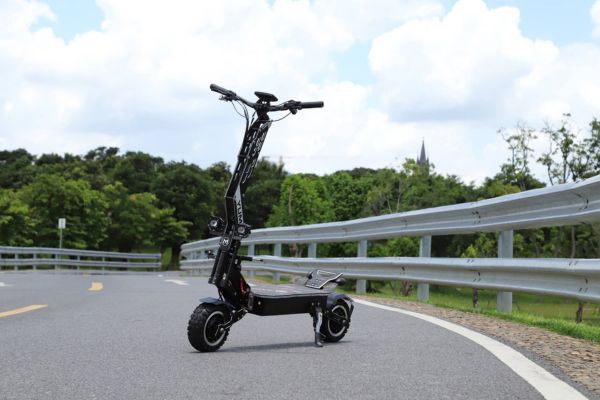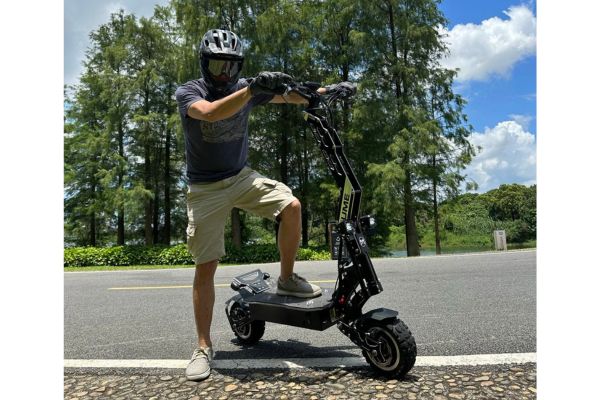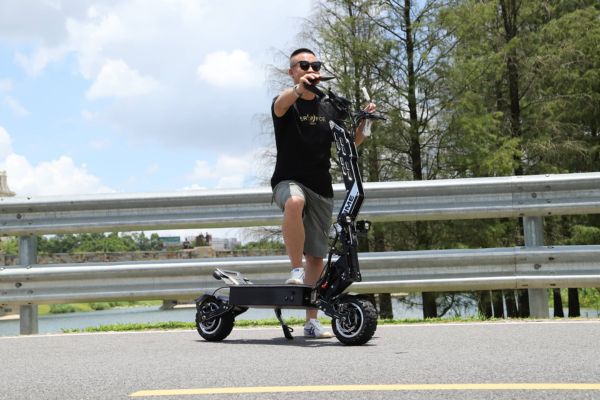The YUME Osprey electric scooter is a bold entry into the “hyper‑scooter” arena. It promises truly astonishing performance, up to 60 MPH top speed, and peak power over 10,000 watts, at a much lower price than well-known brands. This combination of specs and price is compelling.
However, all this power comes with very real trade‑offs. Many users warn about uneven build quality, short warranty coverage on critical parts, and spotty customer support. In short, YUME focuses on giving you striking specs and speed, but this seems to come at the expense of consistent quality control and long‑term reliability.
So the YUME Osprey isn’t clearly “good” or “bad.” It’s a high‑risk, high‑reward vehicle. It might be perfect for a hands‑on, mechanically confident rider who wants raw speed for a low price and is ready to fix or tweak the scooter as needed. But for someone wanting a turn‑key, reliable ride with solid support, it carries too much uncertainty.
Yume Osprey Electric Scooter

At the heart of the Osprey is its dual‑motor setup, each motor rated at 3500 watts, giving a nominal total power of 7000 W, and a peak output of about 10,080 W. That’s what allows the scooter to accelerate hard and reach speeds up to 60 MPH.
What sets it above many cheap scooters is the sine‑wave controllers, two 18‑MOSFET units. Unlike basic square‑wave controllers that deliver power in abrupt, jolting bursts, sine‑wave controllers deliver smooth, precise power. This makes acceleration feel more refined and controllable.
Check PriceThe Energy Source: A Tale of Two Batteries
You can choose between two battery packs:
- The standard option is a 72 V, 36 Ah pack, rated for up to 75 miles.
- The premium option is a 72 V, 40 Ah pack that uses Samsung 50e 21700 cells, giving up to 100 miles of range.
Using Samsung cells is a signal of quality: Samsung is a Tier‑1 battery maker known for reliability and safety. That suggests YUME chose better cells for the premium battery model.
The scooter also includes dual charging ports and two chargers in the box. That means you can charge the large battery faster, fully recharged in about 6–7 hours if you use both chargers simultaneously.
Chassis and Ride Systems: Balancing Comfort and Control
The Osprey is built to manage its power and give a stable ride:
- Suspension: It has adjustable hydraulic suspension on both front and rear. Riders can fine‑tune damping depending on their weight and terrain, a feature usually found on more expensive scooters.
- Braking System: It combines ZOOM hydraulic disc brakes with electronic braking. These brakes use 160 mm discs with cooling fins, giving decent stopping power but at a lower price than luxury brands like Nutt or Magura.
- Tires: The scooter runs on 11″ × 3.95″ all‑terrain tubeless tires. Tubeless tires reduce the risk of flats and are easier to fix with a plug kit, which is much appreciated by riders.
Rider Interface and Connectivity
YUME also included a strong feature set for the cockpit and user controls:
- A large color LCD display shows all essential data: speed, distance, ride mode, and battery level.
- It includes two throttle types in the box: a thumb throttle and a trigger throttle. Riders can swap them easily via a plug; no extra purchase needed.
- Security and connectivity features are modern: NFC card unlock, Bluetooth connection, and a “YUME Ride” smartphone app for locking the scooter and monitoring its status.
YUME’s engineering is centered on putting power and specs up front, while saving money on less visible items. This gives amazing headline numbers, but it also means final assembly and quality control might be inconsistent.
Performance Analysis – Real‑World Dynamics vs. On‑Paper Promises

Top Speed and Acceleration
YUME advertises “up to 60 MPH,” but real-world results vary depending on rider weight, battery charge, and conditions.
One user hit 59 MPH on a YouTube video, which supports the claim. But elsewhere, another user found a mismatch between the display and a GPS reading: the speedometer showed 46 MPH, but the GPS measured only 36 MPH. That 10 MPH discrepancy raises concern over calibration.
Acceleration is delivered smoothly because of the sine‑wave controllers. Some users found it progressive and manageable; others, chasing dramatic launches, felt it lacked punch. It depends on rider preference: smooth ramp‑up or sharp bursts.
Range and Battery Endurance
YUME says 75 miles with the 36 Ah pack, and 100 miles with the 40 Ah Samsung pack. Anecdotal feedback confirms a strong range; one rider said after 30 miles, the battery gauge was not halfway drained, hinting at long-range capability.
However, these numbers assume ideal riding, a light rider, flat surfaces, and slow speeds (e.g., 15 MPH). In real riding with hills, wind, and higher speeds, expect about 50–70% the claimed range. That’s still solid, but far less than the marketing numbers.
Handling, Stability, and Ride Comfort
- On hills, designers claim the scooter can tackle 35–45° inclines thanks to the strong torque from the motors. Real-world terrain and weight affect this, but it signals plenty of hill‑climbing power.
- The adjustable suspension helps absorb bumps and maintain control, reportedly “amazing” and “perfect” in reviews of previous YUME models.
- Weighing 123 lbs (56 kg), it is heavy, which makes it stable at high speed but impossible to carry easily. That weight makes it feel planted and smooth edge control at 60 MPH or more.
Overall, parts like the battery and motors deliver on spec. But speedometer errors and possible mis‑calibrations may require the owner to run a GPS check and adjust internal controller settings (P‑settings) to get accurate speed readings. That ties back to quality control inconsistency.
This scooter works best for someone willing to test, calibrate, and fine‑tune it themselves, not a casual rider.
Build Quality and Reliability – An Examination of YUME’s Manufacturing Ethos
The “YUME Lottery”: Inconsistent Quality Control
One of the most frequent criticisms is what riders call the “YUME lottery.” Build defects vary wildly from unit to unit:
- Forum users describe loose or bare wires, brake calipers falling off, dead batteries on arrival, warped discs, or parts loosely bolted.
- Some users had to completely disassemble the front fork just to tighten dangerously loose steering.
Meanwhile, reviewers sent special units often report solid, wobble‑free frames and good build quality. This gap suggests YUME sends pick‑and‑choose units to reviewers, while regular production units have inconsistent assembly.
This isn’t about the design, it’s about how the scooter is built at the factory. The engineering seems decent, but the final assembly line apparently lacks consistent checks.
The DIY Imperative: Is Mechanical Skill a Prerequisite?
In forums, experienced buyers say flatly: “It’s best to have DIY skills if you buy one”, or: “If you can’t fix a tire or tighten bolts yourself, save up for a Segway or more reliable brand.” Most owners strongly suggest that you WILL do maintenance, possibly soon after purchase. From tightening bolts to wiring inspection, hands‑on skills are essential.
Brand Perception and Evolution
YUME is often listed as the “best of the worst” in enthusiast comparisons to brands like Kaabo or Nami, mostly due to reliability concerns.
That said, features like the Samsung battery option and better finishing touches (like anodizing), suggest the brand may be improving. Some reviewers even call YUME the “most improved scooter company” of the year. But it still must overcome the lingering perception of low assembly standards before being truly trusted.
The Rider Experience – Features, Ergonomics, and Daily Usability
The Cockpit and Controls
The Osprey’s cockpit is surprisingly well‑equipped:
- Backlit large LCD shows speed, mileage, battery level, and ride mode clearly, even while riding.
- It includes both thumb throttle and trigger throttle in the box, easily swapped via plug, something not typical at this price level.
- The package comes with extras: a tool kit, handlebar bag, phone holder, two rear‑view mirrors, and a tire pump. These make the scooter almost fully ready to ride right out of the box.
Safety and Lighting
Safety gear includes:
- Dual bright LED headlights up front, rear brake light, and front/rear turn signals.
- A horn.
- The hydraulic ZOOM brakes, which are safer and more effective than mechanical brakes for a scooter as heavy and fast as this.
The Burden of Mass: Portability and Practicality
At 123 lbs, the Osprey is not portable:
- It’s not practical to carry upstairs, into cars, or on public transport.
- It’s a full‑time ride, not a last‑mile scooter. You need storage on the ground level or elevator access.
- A similar heavy YUME scooter was criticized for poor folding and portability; this one is even heavier.
In short, the Osprey works only for owners with a stable storage setup. It’s not suitable for many apartments or multi‑floor access without help.
Weather Resistance
The scooter has an IP54 rating:
- 5 means guarded against dust enough to not interfere with function.
- 4 means protected from splashing water, but not waterproof.
This allows riding through light rain or splashes. But not in heavy rain or submersion. Water damage is not covered under warranty, so riders must avoid wet conditions.
The Competitive Arena – Osprey vs. The Titans
The Contenders
To understand the Osprey, compare it with other top models:
- YUME Osprey: Around $2,398. Maxes out on power and range, but risks build quality issues.
- Kaabo Wolf King GT: Around $3,799. Known for rugged build, smooth ride, and reliable brand.
- Nami Burn‑E 2 Max: Around $3,899. Premium craftsmanship, lightweight frame, rich customization.
- Vsett 11+ Super 72: Over $4,500. Dual stem design for stability and comfort, heavy but luxurious.
Comparative Analysis
| Feature | YUME Osprey | Kaabo Wolf King GT | Nami Burn‑E 2 Max | Vsett 11+ Super 72 |
| Price | ~$2,398 | ~$3,799 | ~$3,899 | $4,500+ |
| Peak Power | ~10,080 W | ~8,400 W | ~8,400 W | ~8,000 W+ |
| Top Speed | ~60 MPH | ~62 MPH | ~60 MPH | ~62–65 MPH |
| Max Range | ~100 mi (Samsung) | ~90 mi | ~115 mi | ~60 mi |
| Brakes | ZOOM Hydraulic | Full Hydraulic (Zoom) | Full Hydraulic (Logan) | Nutt Hydraulic |
| Suspension | Adjustable | Motorcycle‑grade | Adjustable Coil‑Shock | Dual Hydraulic |
| Weight | 123 lbs (56 kg) | 120 lbs (55 kg) | 103 lbs (47 kg) | ~128 lbs (58 kg) |
| Build Quality | Mixed / DIY Needed | Excellent | Excellent | Excellent |
| Strength | Best price/power | Durability & stability | Ride quality & tuning | Comfort & stable ride |
| Weakness | Reliability risks | Heavy, non‑folding | Minor ergonomics | High price & weight |
All these scooters are blisteringly fast. So premium brands focus on building trust through quality and ride refinement. YUME instead targets shoppers who want maximum spec for minimal spend, and are fine with doing repairs themselves if things go wrong.
The YUME Warranty: A Closer Look at the Fine Print

YUME includes a “Limited 12‑Month Warranty”, but with significant caveats:
- The frame and many mechanical parts get 12 months of coverage.
- The most critical electronic parts, motor, battery, and controller, are covered for only 6 months.
- Wear items like brake pads and tires are covered for just 1 month or 100 miles.
- The warranty excludes water damage, unauthorized modifications, user error, and shipping costs.
That means if your motor or battery fails after six months, you pay out of pocket, even if you used the scooter normally.
Customer Service: A Tale of Two Experiences
YUME claims to have regional service centers and a support email.
- Some reviewers report good experiences, such as personal help from the founder when fixing a review unit.
- But many real‑life users on Reddit report poor support: vague instructions, refusals to send parts, or being told to repair in third‑party shops.
- One echoing post: “Do not buy Yume scooters, their quality is terrible and their customer service sucks.”
Only a few stories of helpful support exist, for example, a user who got a new hub shipped internationally in a week. But those are outliers in a sea of complaints.
Calculating the True Cost of Ownership
The initial price (~$2,398) may seem low, but ownership costs can add up:
- If critical electronics fail after six months, you pay for replacements yourself.
- Shipping a 123‑lb scooter for repair can be very expensive, and shipments are not covered.
- If you lack tools, you may need to buy them. And labor costs or time spent repairing it can be significant.
In effect, YUME shifts much of the risk and expense to the buyer. Lower upfront cost, but potentially expensive later if parts fail outside warranty.
Synthesized Verdict: The High‑Octane Gamble
In the hyper‑scooter market, the YUME Osprey delivers bold performance for a bold price. It democratizes extreme specs: 60 MPH speeds, 10,000 W power, up to 100 miles range, all for under $2,500.
But this speed and power come at a price you don’t see: potential assembly defects, short warranty on core parts, and unreliable support. Many owners report receiving scooters requiring immediate fix‑ups.
Buying an Osprey is less about choosing a scooter and more about choosing a role as a DIY owner. If you enjoy tinkering, checking your scooter on arrival, and can handle repairs or calibration, it’s an unmatched value. If you want something that just works, with low hassle and strong support, the risks may be too high.
Tailored Recommendations for User Profiles
- DIY Enthusiast / Budget Speed Demon: If you live for raw performance, love tinkering, and don’t mind taking responsibility for assembly quality, the Osprey may be your best value. Be ready to inspect and tune it from day one.
- Turnkey‑Reliability Seeker: If you want something that works perfectly out of the box, supported by warranty and service, the Osprey is likely not the right choice. Spending more on a Kaabo, Nami, or Vsett gives more reassurance and fewer surprises.
Conclusion
The YUME Osprey is, without doubt, an engineering statement more than a mass‑market product. It screams ambition: delivering hyper‑scooter performance at a budget price. For riders who want maximum speed, torque, and range for minimal money, the Osprey is unmatched if those riders are mechanically savvy, patient, and understand they might have to repair or refine the scooter themselves.
The scooter’s high peak power, smooth sine‑wave control, and Samsung‑cell battery options deliver real capability, not just marketing hype. But those headline specs mask a much less glamorous truth: assembly flaws, calibration errors, and quality control gaps. The failure patterns aren’t engineering design; they’re typically in the final stages: loose bolts, miswired connectors, poor fastening, and inconsistent finishing.
A strong warning comes from the “YUME lottery”: owner luck heavily determines satisfaction. Some get solid units that perform well from day one. Others get machines that need immediate adjustment or major fixes. This unpredictability sticks to YUME’s brand, so if you’re risk‑averse, the Osprey may not be worth saving a few hundred dollars.
On the flip side, some riders within the community appreciate exactly that setup: they buy, strip it down, verify torque and wiring, and tweak P‑settings. They enjoy it more than a polished, maintained product because they understand how it works and feel in control. For them, the Osprey delivers thrilling performance and value when treated as less of a “plug‑and‑play scooter” and more of a mechanically engaged thrill ride.
The warranty structure reinforces the risk: only six months on motor/battery/controller, and almost no coverage after that. Most competitors offer longer coverage and more reliable support. Osprey owners report needing non‑trivial repairs after the warranty expires, at full cost.
Customer service remains a gamble: professional reviews show quick, helpful interactions. Real owners often experience delayed responses, minimal useful guidance, or even refusal to honor valid claims. While some users report rare good support, the majority report frustration.
Therefore, the bottom line: The YUME Osprey redefines what’s possible for the price in hyper‑scooter territory, but at the cost of stability, assurance, and consistency. Its unique appeal lies in offering premium-level top speed and acceleration at a lower price point, but only to those ready to assume responsibility for the scooter’s final quality and upkeep.
Check Price



